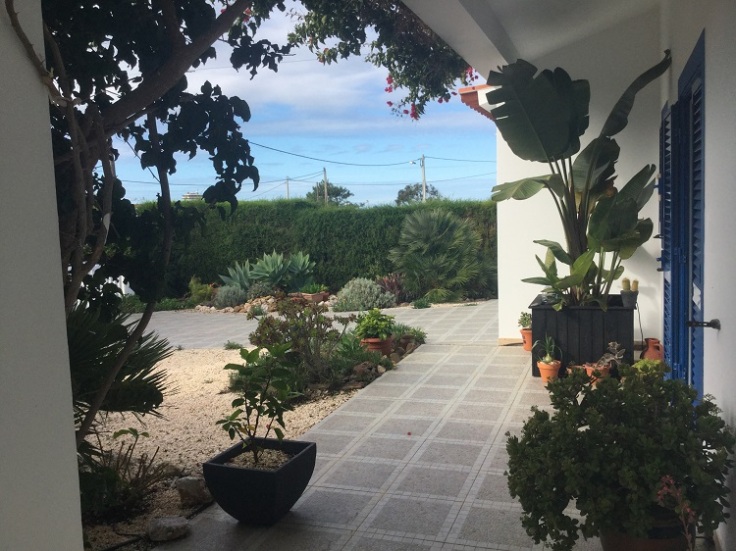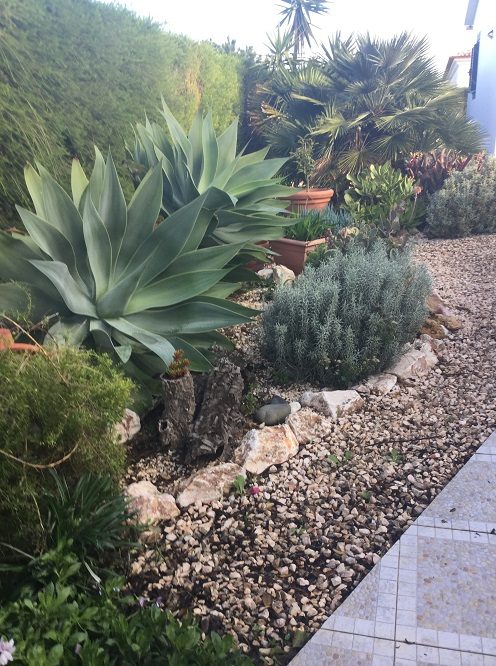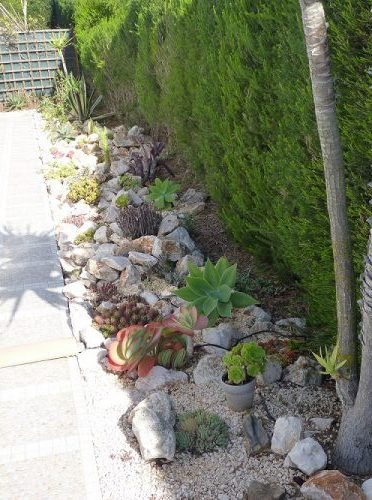‘A Tour of My Garden (part 1)‘ included photographs of our main outside living areas and garden which is south facing and as I said in my previous post:
When I think of the various areas of our garden I try to plan them as different rooms, or a transition from one room to the next. Each room has a different feel and purpose.
1. Entrance
As you walk from the front terrace, which leads to other areas of the garden, you will see I have created a path of interest with various plants in pots which I change according to the season to add colour.
The largest, and hopefully a feature, is the purpose built large black container in the far corner which is home to the strelitzia nicolai (white bird of paradise). The leaves of Strelitzia are now almost touching the ceiling so it won’t be long before I divide the plant and move the largest clump to another area of the garden. The mother plant is now four years old so I live in hope it will produce flowers at some point.
There is also an assortment of cacti and succulents, hibiscus and gazinias. I also use this area to shelter some of my more tender cacti and succulents during the winter months.

2. Side Garden – I
Continuing our journey we arrive at one of the side gardens in which I mainly grow cacti and succulents and a couple of native palms and shrubs. The grey curry plant in the picture below and the palm in the foreground of the second picture both grow wild in the natural park, so they are drought tolerant.


2. Side Garden (II)
On the other side of the house I created a succulent and cacti rockery with over 30 different species and counting. I only built it this year, so many of the plants are still very young.

3. Round the Back
As we continue our journey to the back of the house this area is still very much work in progress. In the foreground I have created another succulent and cacti rockery using a different type of rock and will gradually expand this area over time.

4. Fruit and Vegetable Area
Growing fruit and vegetables has always proved to be quite a challenge. If it’s not blight, white mold or rust it’s fruit flies, snails or cabbage white butterflies to name a few. While I have a raised bed I still have issues with soil and achieving the right balance. Perhaps I should invest in a soil testing kit. The salt winds and high humidity also add to the challenge.
I now tend to grow most of my crop in containers. I will write about this in more depth in another Six on Saturday.
The herb garden in the foreground needs a total revamp. Another project.

*

5. Loquat orNêspera or in Portugal.
This is now in flower and the bees and wasps are crazy for the pollen. Have you ever tried nespera jam or chutney? Both are delicious.

6. Oranges in November
This year our orange tree has produced its best crop ever with nearly 100 oranges! Although its roots fight for airspace with the invasive melaleuca , after a slow start it now seems to be thriving.

If you want to join Six on Saturday check out the guidelines <HERE>
Or view further participants <HERE>


It’s so fascinating seeing what people have in their gardens around the world. Back in January I was hacking five metre stems off Strelitzia nicolae in a garden north of Brisbane in Australia. They had lots of Agave attenuata too. They struggle with cacti, its too wet and humid, though a lot of other succulents do well. The fan palm I have in my own front garden in Cornwall, I think it’s the only plant we have in common.
LikeLike
Hi Jim, thanks for stopping by. I brought the fan palm from the UK only to discover they grow in the wild here. 🙂 It’s was interesting to note when we first started our garden that most of the plants in the UK are available in the garden centres here. I am still adapting to a different style of gardening and totally different challenges – such as the huge array of insects.
LikeLike
Wow, great post.
I learned a lot.
Thanks for sharing! ^_^
LikeLiked by 1 person
Thanks, Cynthia. I am pleased you enjoyed my little plot in Portugal
LikeLike
Fabulous garden Carole, love the succulent side garden and the rockeries.
Our Loquat tree just finished fruiting about 1 month ago, still a lot of rotten fruit on the tree that needs to be pruned.
I have friends who pick most of the fruit as I don’t like it and my husband eats a minimal amount.
I’ve made a Nespera liquor, and have made your jam too 🙂
LikeLiked by 1 person
Thanks, Sami. I missed this years loquat harvest. I was busy and before I knew it the birds got there first!
LikeLike
All looking very beautiful. That cactus ‘room is going to look fab when they grow on a bit.
LikeLike
Thanks, C. I’ve since learned that if I want to enjoy my cacti in this lifetime I will need to buy them a lot bigger. 🙂
LikeLike
So many of the Southwestern American native specie are more popular there and other regions around the Mediterranean Sea than they are here where they are native. Some should be more popular than they are here because they do not want for much water. Yet, we tend to prefer greener and lusher plants. We do not grow medlars here, but loquats are merely loquates (Eriobotrya).
LikeLiked by 1 person
Well spotted, Tony! i was told when I first planted the tree it was a medlar/Nespera. It’s not a medlar tree. I’ve taken a closer look at the fruits and mine is most def a Nespera/Loquat. We live to learn! I’ve updated the photo and info above. 🙂
but on the otherhand I’ve just checked and it could be a Japanese medlar
https://www.thespruceeats.com/nisperos-loquats-medlars-3083499
https://en.wikipedia.org/wiki/Loquat
Now I am totally confused
LikeLiked by 1 person
What?! Now I am confused too. I just figured that it was a medlar because I do not know what a medlar looks like.
LikeLiked by 1 person
Laughing… and I thought succulent identification was tough. This is also a medlar
https://www.growveg.com/guides/in-praise-of-medlars-get-the-most-from-these-delicious-fruit/
LikeLiked by 1 person
I NEVER heard it referred to as ‘cul de chien’. That is just . . . weird. Anyway, it does not look like a loquat to me. The foliage is sort of similar, but the bloom and the fruit are very different. So, is yours a medlar?
By the way, don’t pears blet like medlars? I mean, they are too hard to eat straight off the tree. Why would that be a problem for medlars?
LikeLike
Oh my! Thank you for the tour – I can see why you garden everyday, do you take time to sit down, relax and enjoy your hard work?
LikeLiked by 1 person
Absolutely. I have created lots of seating areas where I can take breakfast, coffee, lunch and G &Ts
LikeLiked by 1 person
Beautiful garden!
LikeLike
Aw, thank you salty. do you have a garden? 🙂
LikeLiked by 2 people
Yes, but it is by the sea so it mostly has cacti.
LikeLike
We are also by the sea… it’s a challenge, yes?
LikeLiked by 1 person
Very much so, but olive trees do grow.
LikeLike
Ah … and how much you save on mowing the lawn!
🙂
LikeLiked by 1 person
We have no lawn but have a huge hedge that needs mowing. 🙂
LikeLiked by 1 person
Portuguese style, as they say over here. Concrete everything and paint it green!
LikeLike
Wonderful post and an even more wonderful garden 🙂
LikeLiked by 1 person
Thank you, Becky. Walking is your passion – gardening is mine. 🙂
LikeLike
😊
LikeLike
Interesting i live in Perth Western Australia in Australia..cold in winter really hot in summer..beautifull city.. if you go south its the most stunning country green and harsh but so inviteing.. go north its ruggered, hard, red, hot but stunning with its visuals with land that ask why are you here but welcome to my land.
LikeLiked by 1 person
A friend of mine lives in Perth she blogs at Sami Colourful World. i love looking at her photographs.
LikeLiked by 1 person
Oh wow, it’s like I am walking with you through the garden. The more I see, the more I love it 🙂
LikeLiked by 1 person
Now when I say I’m gardening you can see the fruits of my labour. My mind is never still when it comes to gardening.
LikeLike
Im getting there Mis Piglet in Portugal..i have to ask is Portugal a beautiful place from what i have seen there is certanly some stunning looking country.
LikeLiked by 1 person
Portugal is a diverse country. I’m on the SW coast of ALgarve which is unspoilt but a little windy at times. Then there is SOuthern ALgarve which can get very hot. Up North is cold in winter and hot in summer.
LikeLike
It certainly is a stunning setting well done..and the garden is magic well done Mis Piglet in Portugal.
LikeLike
Thank you Lardy. Gardening is my passion. I did check out your blog and subscribed but note you have no content as yet.
LikeLike
I did not realize you were so close to the sea! No wonder you are having problems already caused by the inevitably windy conditions and the salt in the air ! Narrows down the choice of what you can grow. We share a commonality in gardening I also use lots of pots I can move around and having ‘down-sized’ some years back with now a smaller garden, I grow all my herbs and tomatoes, peppers, chillies etc in the sun along my side wall with no windows . . . works great . . . just love your Bird of Paradise: have never grown the tall white one . . .
LikeLiked by 1 person
YEs, it is a real challenge gardening here, EH. If it’s not the sea salt wind it’s the humidity. I’ve lost countless plants and trees. Pots are certainly a great solution for positioning plants in the sun or shade and great if you have a small garden.
LikeLike
Wow!! Your garden is absolutely stunning!!!!!
LikeLike
Thank you sarsm, good to see you are still blogging 🙂 So many of us oldies have disappeared.
LikeLiked by 1 person
What an incredible garden you have. Your tour is so thoughtful, I love how you take us from one part to the next with such caring. ❤ And 100 oranges – wow! Thank you for this post, you inspired me. Blessings to you.
Debbie
LikeLiked by 1 person
thank you Debbie. As i am new to the challenge I thought I’d take people on a tour before I delved deeper 🙂 I am pleased you enjoyed the journey,
LikeLiked by 1 person